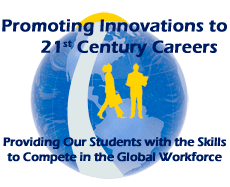21st Century Careers
Promoting Innovations to 21st Century Careers
A skilled, prepared workforce in our nation is more critical than
ever before as we strive to compete in an increasingly global and
dynamic economy. I have been a long-time advocate for
workforce development and education programs that open the door to the
21st century skills needed for career success. We must make investments that help
working families prosper, while contributing to the economic strength
and well-being of our nation. I believe that effective and coordinated
education and workforce development efforts are critically important,
particularly as so many families across the nation struggle just to
stay afloat in this tough economic climate.
and
dynamic economy. I have been a long-time advocate for
workforce development and education programs that open the door to the
21st century skills needed for career success. We must make investments that help
working families prosper, while contributing to the economic strength
and well-being of our nation. I believe that effective and coordinated
education and workforce development efforts are critically important,
particularly as so many families across the nation struggle just to
stay afloat in this tough economic climate.
The new global economy has meant new opportunities for Washington state and our nation, but it has also presented us with real challenges. I am deeply troubled by the widening gap between the number of jobs that are available in growing fields from health care to energy development – and the number of workers who have the skills to fill those jobs. Drop-out rates and unemployment rates remain high. As our economy continues to recover, it is clear that we must find innovative ways to make education work for our students and our businesses.
Over the past few years, I have traveled throughout the state of Washington, bringing together students, educators, workforce leaders, employers, and labor officials to talk about solutions. The result is legislation that I am reintroducing for the 112th Congress – the Promoting Innovations to 21st Century Careers Act.
My bill would provide support to communities, employers and schools to work together and identify ways to open up “career pathways” that help our students get the knowledge and skills they need to succeed by providing for:
-
New Resources – The bill establishes $930 million in federal grants that can be used by state and regional partnerships to help students move from high school, to a wide array of post-secondary education options, to skilled careers.
-
Strong Partnerships – It requires state and regional partnerships applying for funding to include representatives from high schools, post-secondary education, business, labor, workforce, and economic development.
-
Innovation – It encourages state and regional partnerships to develop career pathways for high school students that include counseling, mentoring, work-based experiences, and assistance in obtaining degrees, apprenticeships, and other postsecondary credentials.
-
Real Accountability – The bill incorporates measures to evaluate the success of state and regional efforts, including reports to Congress.
Education is the key to a bright future, and I’m hopeful that the ideas I’ve presented in my bill will fuel a national discussion about ways we can improve education and keep our economy strong.
More on: Education
Related Documents
- Bill Summary - Promoting Innovations to 21st Century Careers - Career Pathways Summary - 2011.pdf (548.7 KBs)
- Support for Promoting Innovations to 21st Century Careers - CP-quotes.pdf (389.7 KBs)